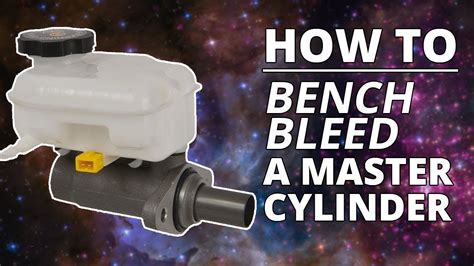How to Bleed a Master Cylinder (Without the Fuss)
Bleeding a master cylinder is a crucial maintenance task for any vehicle's braking system. A properly bled system ensures firm, responsive brakes, vital for safe driving. While it might seem daunting, bleeding a master cylinder is manageable with the right tools and approach. This guide will walk you through the process, minimizing the fuss and maximizing your success. We’ll cover everything from preparation to the final check, ensuring you can tackle this job with confidence.
What You'll Need:
- Brake fluid: Use the correct type specified in your vehicle's owner's manual. Never mix different types of brake fluid.
- Clean rags or shop towels: Brake fluid is corrosive, so cleanup is essential.
- Clear tubing: This will allow you to see the fluid flow and spot any air bubbles.
- Wrench: The size will depend on your vehicle's bleeder screw.
- Container: To catch the old brake fluid.
- Assistant (recommended): Having someone pump the brake pedal significantly simplifies the process.
Why Bleed Your Master Cylinder?
Air in the braking system is the enemy. It compresses under pressure, resulting in a spongy or unresponsive brake pedal. This can lead to significantly reduced braking performance, putting you and others at risk. Bleeding the master cylinder removes this air, restoring full braking power. Common reasons for needing to bleed your master cylinder include:
- Brake system repair: After replacing brake lines, calipers, or other components.
- Low brake fluid: If the fluid level has dropped significantly, air may have entered the system.
- Spongy brake pedal: A soft or mushy pedal is a clear indication of air in the lines.
- Routine maintenance: As part of regular vehicle maintenance, bleeding the master cylinder can help prevent future problems.
Step-by-Step Guide to Bleeding a Master Cylinder
1. Preparing for the Bleed:
- Park on a level surface: This ensures accurate fluid levels and prevents air pockets from forming.
- Engage the parking brake: Safety first!
- Locate the master cylinder: This is typically found under the hood, near the brake booster.
- Check the brake fluid level: Top it off if necessary, using the correct type of fluid.
2. Locating Bleeder Valves:
- Identify the bleeder valves: These are small screws usually located on the brake calipers.
- Gather your tools: Have everything within easy reach to avoid delays.
3. The Bleeding Process:
- Attach the clear tubing: Connect one end to the bleeder valve and the other end to your container.
- Have your assistant pump the brake pedal: Instruct them to pump the pedal firmly but slowly several times.
- Open the bleeder valve: Slowly open the valve with the wrench, allowing fluid to flow into the tubing. You should see fluid and potentially some air bubbles.
- Close the bleeder valve: Once the fluid runs clear of air bubbles, close the valve tightly.
- Repeat the process: Continue this process until no more air bubbles are visible in the tubing. You may need to repeat this for each brake caliper.
4. Checking Fluid Levels:
- Replenish Brake Fluid: Top off the master cylinder's brake fluid reservoir as needed.
5. Final Test:
- Test the brakes: Pump the brake pedal several times to feel for firmness. If the pedal still feels spongy, repeat the bleeding process. If the problem persists, you may have a more significant issue requiring professional attention.
Troubleshooting Common Issues
H2: What if I can't get all the air out?
If you're struggling to remove all the air, make sure the brake fluid reservoir remains topped off throughout the process. Insufficient fluid can introduce more air. Additionally, check for any leaks in the brake lines or calipers. If the problem persists, seek professional assistance.
H2: How often should I bleed my master cylinder?
The frequency of bleeding depends on your vehicle's age, driving conditions, and maintenance history. However, it’s a good practice to include it as part of your routine brake system maintenance – ideally every couple of years.
H2: What happens if I don't bleed my master cylinder?
Failing to bleed your master cylinder can lead to impaired braking performance. The spongy brake pedal will make it difficult to stop safely, significantly increasing the risk of accidents. Don't risk it!
H2: Can I bleed my master cylinder myself, or should I take it to a mechanic?
While bleeding a master cylinder is a DIY-friendly task for many, if you're uncomfortable working with your braking system or encounter unforeseen difficulties, it's best to seek professional help from a qualified mechanic. Your safety should always be the top priority.
By following these steps and addressing potential issues proactively, you can effectively bleed your master cylinder and restore your braking system's optimal performance. Remember always to prioritize safety and consult a professional if you encounter difficulties.

